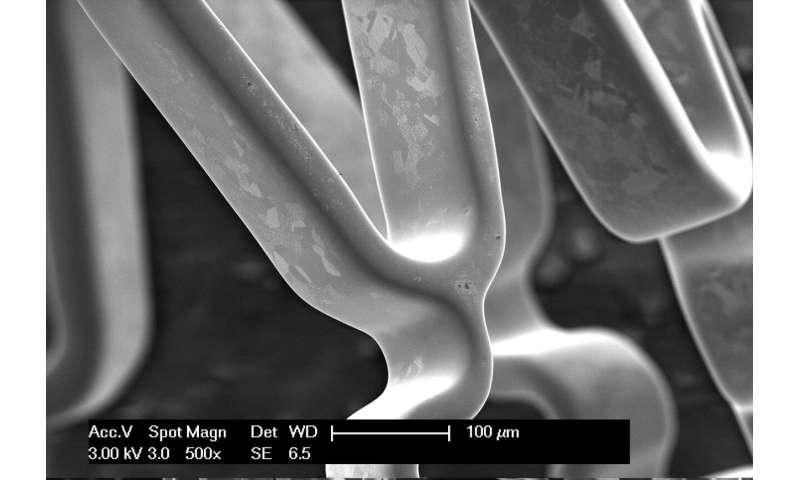
Cardiovascular stents are special implants used to widen blood vessels that have become constricted as a result of calcium deposits. In some cases, the body’s immune system can reject these implants in a process known as foreign-body reaction. In a joint project with partners, Fraunhofer researchers in Dresden have now developed enhanced coatings that substantially improve the biocompatibility of stents.
When blood vessels become narrowed as a result of calcium deposits, there is a real risk of an infarct or stroke. In such cases, physicians will prescribe the insertion of stents. These are fine tubes of stainless-steel mesh. Once inserted, they are expanded in order to keep the blood vessel open. Around one-quarter of all patients display an immune response with undesirable effects such as inflammation, a rejection of the stent as a foreign body or its encapsulation with tissue. These reactions mean that the blood vessel is more likely to become constricted again. In response, manufacturers are now starting to coat stents as a way of increasing biocompatibility. Typical coatings include titanium oxynitride, a compound of titanium, oxygen and nitrogen. However, the coating process does not always produce perfect results: there may be gaps in coverage and variations in coating thickness. So while coatings can reduce the risk of foreign-body reaction, they cannot completely eliminate all such complications.
An enhanced coating process
In a collaborative project with Polish stent manufacturer Balton, the Russian company VIP Technologies and the University POLITEHNICA of Bucharest, a research team from the Fraunhofer Institute for Ceramic Technologies and Systems IKTS has now been able to enhance these stent coatings and, in the process, substantially improve their biocompatibility. The project is jointly sponsored by the German Federal Ministry of Education and Research (BMBF). “Biocompatibility depends on a range of material properties, including roughness of the surface, wettability and the chemical composition of the coating,” explains Dr. Natalia Beshchasna, project leader and scientist at Fraunhofer IKTS. “By enhancing the coating process, we’ve been able to fine-tune these parameters, which in turn has improved the biocompatibility of the stents. Specifically, we’ve been able to increase the degree of coverage by ten percent—the coating now covers 90 percent of the stent, up from 80 percent.” This was no easy task, since the outer surface of the stent must be tissue-compatible and the inner surface blood-compatible. Moreover, the coating must evenly cover the entire surface of the mesh structure, and it must be thick enough and elastic throughout so that the stent is not damaged when expanded within the blood vessel.
Fine-tuning the chemical composition

As a rule, such coatings are produced by means of a plasma. This plasma is generated by bombarding a titanium target, in a vacuum chamber, with argon ions. This bombardment strips off titanium atoms from the target. A gas mixture of oxygen and nitrogen is then fed into the chamber, which results in the stent being coated by a compound of titanium, oxygen and nitrogen. In trying to optimize the coating, the research team concentrated on its chemical composition and, in particular, the ratio of oxygen to nitrogen. “We created a matrix according to which we varied the ratios of the gases,” Beshchasna explains. These ratios are adjusted by varying the amount of each gas that is fed into the vacuum chamber. The different coatings produced in this way were then examined for a range of properties, including surface morphology, chemical composition and wettability. The results show that the optimal ratio of oxygen to nitrogen is three to five.
Exposure to a constant stream of blood
It was also vital to determine whether the coating would withstand exposure to a constant stream of blood. To answer this question, the research team built an experiment in which the surface of the stent was exposed to a flow of synthetic blood plasma at varying temperatures, pressures and flow speeds. The coating was subjected to this procedure for a period of two months. At the end of the experiment, the coating had remained fully intact, and no residues were to be found in the test fluid.
Source: Read Full Article






